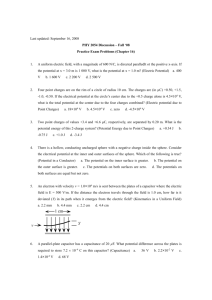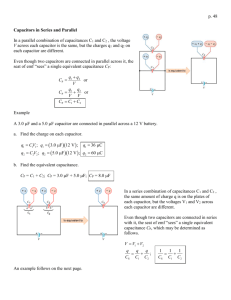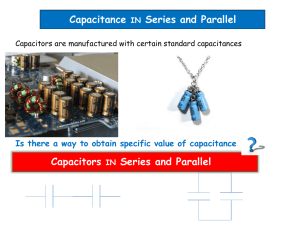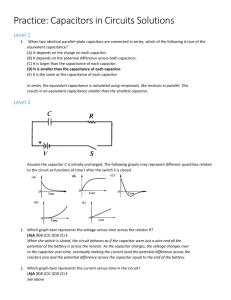Capacitors - Galileo - University of Virginia
advertisement
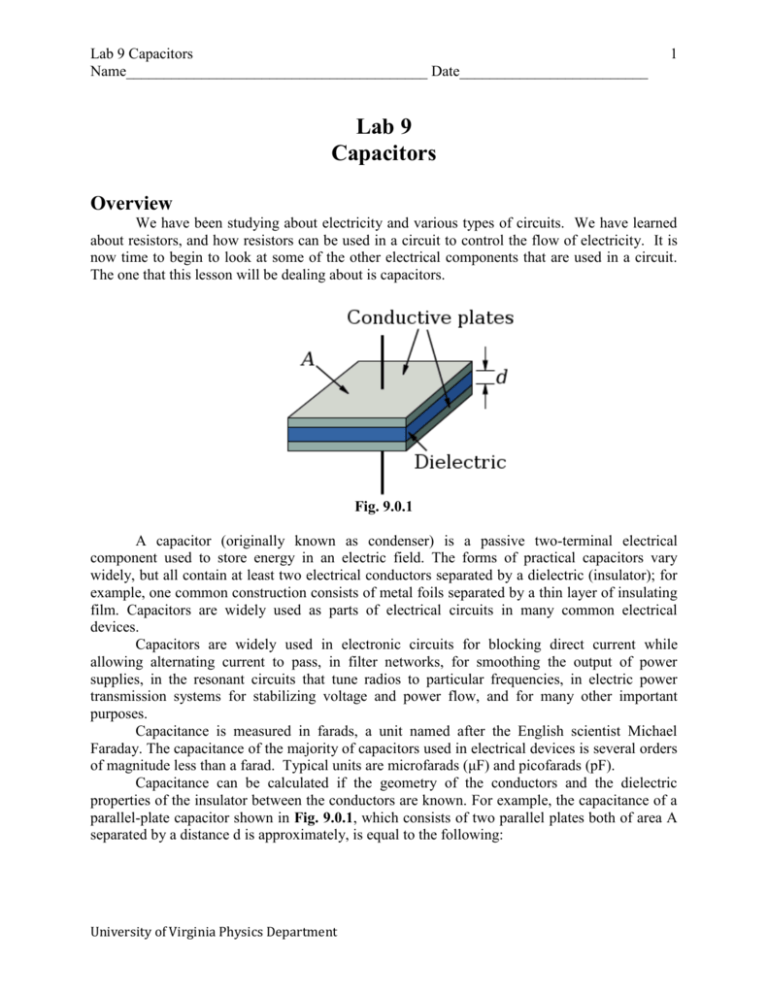
Lab 9 Capacitors Name________________________________________ Date_________________________ 1 Lab 9 Capacitors Overview We have been studying about electricity and various types of circuits. We have learned about resistors, and how resistors can be used in a circuit to control the flow of electricity. It is now time to begin to look at some of the other electrical components that are used in a circuit. The one that this lesson will be dealing about is capacitors. Fig. 9.0.1 A capacitor (originally known as condenser) is a passive two-terminal electrical component used to store energy in an electric field. The forms of practical capacitors vary widely, but all contain at least two electrical conductors separated by a dielectric (insulator); for example, one common construction consists of metal foils separated by a thin layer of insulating film. Capacitors are widely used as parts of electrical circuits in many common electrical devices. Capacitors are widely used in electronic circuits for blocking direct current while allowing alternating current to pass, in filter networks, for smoothing the output of power supplies, in the resonant circuits that tune radios to particular frequencies, in electric power transmission systems for stabilizing voltage and power flow, and for many other important purposes. Capacitance is measured in farads, a unit named after the English scientist Michael Faraday. The capacitance of the majority of capacitors used in electrical devices is several orders of magnitude less than a farad. Typical units are microfarads (μF) and picofarads (pF). Capacitance can be calculated if the geometry of the conductors and the dielectric properties of the insulator between the conductors are known. For example, the capacitance of a parallel-plate capacitor shown in Fig. 9.0.1, which consists of two parallel plates both of area A separated by a distance d is approximately, is equal to the following: University of Virginia Physics Department Lab 9 Capacitors Name________________________________________ Date_________________________ 𝑪 = 𝑲𝜺𝟎 where 2 𝑨 𝒅 C is the capacitance; A is the area of overlap of the two plates; K is the dielectric constant of the material between the plates (for a vacuum, K = 1); ε0 is the permittivity of free space and has the value ε0 =8.854×10−12 F m–1 and d is the separation between the plates. Capacitance is proportional to the area of overlap and inversely proportional to the separation between conducting sheets. The closer the sheets are to each other, the greater the capacitance. The equation is a good approximation if d is small compared to the other dimensions of the plates so the field in the capacitor over most of its area is uniform, and the so-called fringing field around the periphery provides a small contribution. The above equation can also be written as 𝑨 𝑪=𝛜 𝒅 where ε = Kε0 and ε is called the permittivity of the dielectric material. The value of K of paper is affected by several different factors. Paper can be woodbased, rice-based or rag-based for example. Different inks and bleaching processes are used in its production as well as various surface finishes. Wood-based paper – presently the most common paper undergoes a drying process and chemical process with aging. Residual acids left on the surface from the manufacturing process cause the paper to yellow and become drier over time. In addition, paper is hygroscopic and the dryness of paper is very important for the value of the dielectric. For this reason, the value of the dielectric constant can vary from a value as low as 1.7 to as high as 4.0. [1] [1] http://users.df.uba.ar/sgil/physics_paper_doc/papers_phys/e&m/dielectr_const_2k4.pdf University of Virginia Physics Department Lab 9 Capacitors Name________________________________________ Date_________________________ 3 Activity 9 – 1: How to Measure Capacitance Objective: Measure the capacitance of a capacitor. Materials: Multimeter Multimeter leads Breadboard 47 microfarad capacitor Procedure: 1. Place a 47-microfarad capacitor into the breadboard as shown in Fig. 9.1.1. Fig. 9.1.1 2. Turn the multimeter on by pushing the POWER button. Turn the dial so that it points to 200 uF. The dial will be pointed 10 o’clock. 3. Insert the multimeter leads into the two middle openings at the bottom of the meter. Standard practice is to put the red lead into the left middle (mA) opening and the black lead into the COM opening next to (mA). University of Virginia Physics Department Lab 9 Capacitors Name________________________________________ Date_________________________ 4 4. Touch the two probes to either leg of the capacitor. The red probe lead (+) should touch the long leg of the capacitor. The black probe lead should touch the short leg of the capacitor. 5. The schematic for this activity is shown in Fig. 9.1.2. Record the capacitance of the capacitor including appropriate units. Compare the measured capacitance with the nominal 47 microfarads of the capacitor. ______________________________________ Fig. 9.1.2 6. Reverse the two probes. Touch the red probe to the short leg of the capacitor and the black probe to the long leg of the capacitor. Record the capacitance of the capacitor including appropriate units. Compare the measured capacitance with the nominal 47 microfarads of the capacitor. Does changing the probes change the magnitude of the capacitance? _____________________________________________________________ University of Virginia Physics Department Lab 9 Capacitors Name________________________________________ Date_________________________ 5 Activity 9 – 2: Construction of a capacitor Objective: We will learn how distance and area affect the ability of a capacitor to store energy. Materials: VOM (digital multimeter) Meter with Capacitance Meter Wires to connect to VOM Fat textbook or thick phone book (from home) 2 sheets of aluminum foil (from home) Ruler with centimeter scale (from home) Graph paper or Computer Spreadsheet program (from home) Scissors (from home) Procedure: Part A 1. Cut out two sheets of 14cm x 14cm aluminum foil so that your sheets are the same size, and will just fit into your fat textbook. 2. With your ruler, measure the actual length and width of your sheets of aluminum foil. Record the values here. Then calculate the area of your sheets. ________________________________________________________________________ 3. You need to determine the thickness of a sheet of paper in the book that you are using. With your ruler measure the thickness of your all your book pages. Do not include the thickness of the book covers. Record the thickness of the paper in the entire book, not including the covers. Then find out the number of pages there are. __________________ 4. Determine the conversion factor for separation by dividing the thickness of the book in cm by the number of pages. Record the value here. ______________________________ 5. Cut a small rectangular aluminum tab on each of your aluminum foil sheets. This is where you will connect a wire lead. 6. Place your aluminum foil sheets inside your fat textbook separated by 2 pages. 7. Place a heavy mass upon the top of the textbook. This will press the sheets of paper close together. This is very important for the success of the lab. 8. Carefully hook your VOM digital multimeter to the tabs on your aluminum foil sheets. Adjust your meter to determine the capacitance of your sheets of aluminum foil. 9. Record the # of pages in between and the capacitance in Table 9.2.1. ________________ University of Virginia Physics Department Lab 9 Capacitors Name________________________________________ Date_________________________ Separation # of pages Separation (cm) Capacitance (F) 6 Dielectric Constant K 2 4 8 16 32 64 128 Table 9.1.1 10. Increase the distance between the aluminum foil by moving one of the sheets of aluminum foil to a later page in the book. Repeat steps 7 – 9 until you have a total of six data points. 11. Determine the Separation (cm). To do this, multiply your Separation # of pages by your conversion factor determined in step 4. 12. Determine the values for your dielectric constant K and record them in Table 9.2.1. Note that you must convert cm to m in your equation to determine K. 13. Calculate the average value for your dielectric constant. Record your value here. _______ 14. Compare your average dielectric constant value to the value for the dielectric constant for paper given in the Overview. _______________________________________________ 15. On your sheet of graph paper or in a spreadsheet, graph the capacitance vs. separation (cm). When you graph Capacitance vs. Separation (cm), the Capacitance is on the y-axis. Include a copy of your graph here. 16. Does your graph look like a linear relationship? Explain your answer. If so, determine the slope of the linear line and record the value here. ________________________________ Part B 17. Now we will determine if there is a relationship between area and capacitance. Separate the two 14cm x 14cm square sheets of aluminum foil by 16 sheets in the book. We will keep this separation distance constant, and vary the area of the aluminum foil sheets. 18. Place the heavy mass upon the book, and with your multimeter, measure the capacitance of the two sheets of aluminum foil. Remember that you are keeping the separation constant. Record your values in Table 9.2.2. 19. With your scissors, reduce the area of your aluminum sheets. Go from 14cm square to 10cm, 7cm, 5cm, 4cm, 3cm. It will work best if you reduce the area each time by cutting out a smaller rectangular region of each aluminum sheet. Measure the actual length and width of your sheets and record the values in Table 9.2.2. University of Virginia Physics Department Lab 9 Capacitors Name________________________________________ Date_________________________ Length cm Width cm Area cm2 Capacitance (F) 7 Dielectric Constant K Table 9.2.2 20. Repeat steps 18 and 19 until you have a total of six data points. 21. Determine the values for your dielectric constant K and record them in Table 9.2.2. 22. Calculate the average value for your dielectric constant. Record your value here. ________________________________________________________________________ 23. Compare your average dielectric constant value to the range of values for the dielectric constant for paper given in the Overview. ______________________________________ 24. Make a graph of capacitance vs. area. Does this graph look like a linear relationship? If this graph does look like a linear relationship, use the linear fit function in Excel to, determine the slope of the graph. Record the slope here. What is the unit of the slope? ________________________________________________________________________ 25. Include a copy of your graph here. 26. Summarize the relationship between capacitance, sheet separation distance, and the area of the sheets. _____________________________________________________________ University of Virginia Physics Department Lab 9 Capacitors Name________________________________________ Date_________________________ 8 Activity 9 – 3: Capacitors in parallel and series Introduction: Many capacitors are polarized. This means that one end of the capacitor is positive, and the other end of the capacitor is negative. Many capacitors are polarized to protect the central layer of the dielectric material that separates the plates. When a capacitor fails, it will heat up, possibly leading to a short circuit, or it may crack the case. In Activity 1 we did not need to worry about this; now we do. One way that the manufacturers of the capacitors indicate polarity is to place a black stripe on the negative side of your capacitor. Another way to indicate the negative side of the capacitor is to make the negative lead wire shorter. The formula for combining capacitors in parallel is C1 || C2 = C1 + C2. The formula for 1 1 combining capacitors in series is 𝐶1 && 𝐶2 = + . (We use the || symbol for parallel 𝐶1 𝐶2 combination, and the && symbol for series combination, following the convention in computer programming.) We will check our formula in the following experiments. Objective: The student will explore the relationship between capacitors hooked in parallel and in series. Materials: Bag of assorted electrical components Multimeter Breadboard Jumper Wires Scotch tape (from home) Procedure: Part A 1. From your bag of assorted electrical components, remove your capacitors. Capacitors may look like the one shown in Fig. 9.3.1 or the one in Fig. 9.3.2. Fig. 9.3.1 Fig. 9.3.2 2. Once you have sorted out your capacitors, and located the negative lead of your capacitor, hook them to your VOM with capacitance to measure the capacitance of your University of Virginia Physics Department Lab 9 Capacitors Name________________________________________ Date_________________________ 9 capacitors. Record the values in Table 9.3.1. Label the capacitors with tape if needed so that you will be able to distinguish the capacitors. Label them C1, C2, etc. in Table 9.3.1. The manufacturer usually puts the value of the capacitance on the capacitor. Record the measured values and the manufacturer’s values in Table 9.3.1. Capacitor Label Capacitance (uF) Manufacturer Value (uF) Table 9.3.1 3. Using your breadboard, select the two 47uF capacitors and hook them up in parallel. Be sure that you hook up the capacitors with the proper polarity. See Fig. 9.3.3 for a schematic of the proper construction. Use your VOM to determine their combined capacitance. Record the value in Table 9.3.2. Fig. 9.3.3 Capacitor Combination (Example: 47.7 || 47.3) Measured Capacitance (uF) (Example: 91.8) Table 9.3.2 4. Repeat step 3 with i) 10uF and 10uF, ii) 47uF and 10uF, iii) a different 47uF and a different 10uF. Finally, select any three capacitors and repeat step 3. Record the combined capacitances in Table 9.3.2. 5. Generally, when you put capacitors in parallel, is the combined capacitance bigger or smaller than each of the original ones? Explain the reason why. (Hint: you can either do a mathematical proof, or just draw an analogy to increasing/decreasing the area of the parallel plates in a single capacitor.) __________________________________________ University of Virginia Physics Department Lab 9 Capacitors 10 Name________________________________________ Date_________________________ Part B 6. Now hook the two 47uF capacitors in series on your breadboard, and determine the equivalent capacitance. See Fig. 9.3.4 for a schematic of the proper construction. Remember the to be sure the polarity of the capacitors is hooked up properly. This time that will mean that you will hook the positive of one capacitor to the negative of the other capacitor. Record your capacitor combinations and the measured capacitance in Table 9.3.3. Fig. 9.3.4 Capacitor Combination (Example: 47.1 && 47.2) Measured Capacitance (uF) (Example: 23.7) Table 9.3.3 7. Repeat step 6 with i) 10uF and 10uF, ii) 47uF and 10uF, iii) a different 47uF and a different 10uF. Finally, select any three capacitors and repeat step 3. Record the combined capacitances in Table 9.3.3. 8. Generally, when you put capacitors in series, is the combined capacitance bigger or smaller than each of the original ones? Explain the reason why. (Hint: you can either do a mathematical proof, or just draw an analogy to increasing/decreasing the distance of separation between the parallel plates of a single capacitor.) _______________________ 9. In Table 9.3.4, enter all the data you have gathered in this activity, and calculate percentage error for each data run. How do you account for the error? Capacitor Combination Series/Parallel University of Virginia Physics Department Measured Capacitance (F) Theoretical Capacitance (F) Percent Error (%) Lab 9 Capacitors 11 Name________________________________________ Date_________________________ Table 9.3.4 University of Virginia Physics Department Lab 9 Capacitors 12 Name________________________________________ Date_________________________ Activity 9 – 4: Analyzing an RC* Circuit * RC stands for resistor-capacitor, not remote control. Objective: To observe charging and discharging of a capacitor when you hook a resistor and capacitor in series. Materials: 1 kΩ Resistor 100 kΩ Resistor Red LED 47µF Capacitor 220µF Capacitor Breadboard Wire leads VOM multi-meter 9 volt battery (from home) Computer Spreadsheet (from home) Stopwatch (from home) Procedure: 1. On your breadboard, wire the 1kΩ resistor or larger and the 47µF capacitor in series with the LED. The LED has a positive side and a negative side. It the two legs are of different length, the longer leg is the positive side and the shorter one is the negative side. Some LED’s have the legs the same length. In this case look inside the LED and you will find two triangular pieces of metal. One of these triangular pieces of metal will be smaller than the other. The smaller of the two pieces is the positive side of the LED and the larger of the two will be the negative side of the LED. You will hook the negative side of the LED to the positive side of the capacitor. See Fig. 9.4.1 Fig. 9.4.1 University of Virginia Physics Department Fig. 9.4.2 Lab 9 Capacitors 13 Name________________________________________ Date_________________________ 2. Hook the positive side of the LED to the positive side of 9-volt battery, and the negative side of your battery to the resistor. See Fig. 9.4.1. Submit a photo of your circuit. 3. Describe what happens to the LED in your circuit. _______________________________ 4. Remove the battery from the circuit, and insert a short jumper wire where the battery was. See Fig. 9.4.3. Fig. 9.4.3 5. This would normally allow the capacitor to discharge, but since the LED will only allow current to flow in one direction, this will not happen. Switch the direction of the LED. Describe what happens now. Where does the energy come from to light the LED after the battery is removed? ____________________________________________________ 6. Based upon what we have just observed, we see that the current flow through this circuit is reduced very quickly over time. We can change this time by increasing the resistance or capacitance. Use a short piece of wire and short out any charge that remains on the capacitor before you make any new measurements. Replace the 1-kΩ resistor, with a 100-kΩ and add an ammeter in series in the circuit in between the resistor and capacitor. Use the 20-ma or 2-ma scale on the meter. Connect up the battery to the circuit and the LED as in step 1 and watch the current decrease. Disconnect the battery, reverse the LED and replace the battery with a short jumper wire and include the ammeter in the circuit. Describe the brightness of the LED. ___________________________________ 7. Now replace the 47 uf capacitor with the 220 uF capacitor. Remove the LED from the circuit. Connect up the 100–kΩ resistor and battery to the circuit as in step 1. Watch the current decrease as the capacitor charges up. Disconnect the battery and replace the battery with a short jumper wire. The current will slowly decrease. With your ammeter University of Virginia Physics Department Lab 9 Capacitors 14 Name________________________________________ Date_________________________ and a stopwatch measure the current every 2 seconds. Record the time and current values in Table 9.4.1. Time (sec) Current (milliamps) 0 2 4 6 8 10 12 14 16 18 20 22 24 26 28 30 32 34 36 38 40 42 44 46 48 50 52 54 56 58 60 62 64 66 68 70 72 74 76 78 80 University of Virginia Physics Department Lab 9 Capacitors 15 Name________________________________________ Date_________________________ 82 84 86 88 90 Table 9.4.1 8. From the data in the Table 9.4.1 estimate the time it took for the current to reduce to ½ of its original value at t=0. Record the time here. Also measure the resistance R. _______________________________________________________________________ 9. The theoretical time it takes the current to reduce to half of its original value is given by t = 0.69 x R x C, using SI units. Since the multimeter cannot measure over 200uF, we will use the manufacture’s value, so C = 220uF. What is the theoretical time for your circuit? ________________________________________________________________ 10. Plot a graph of current vs. time using Excel. Include a graph here. 11. Comment on the agreement or disagreement between your value and the theoretical value. _________________________________________________________________ University of Virginia Physics Department


